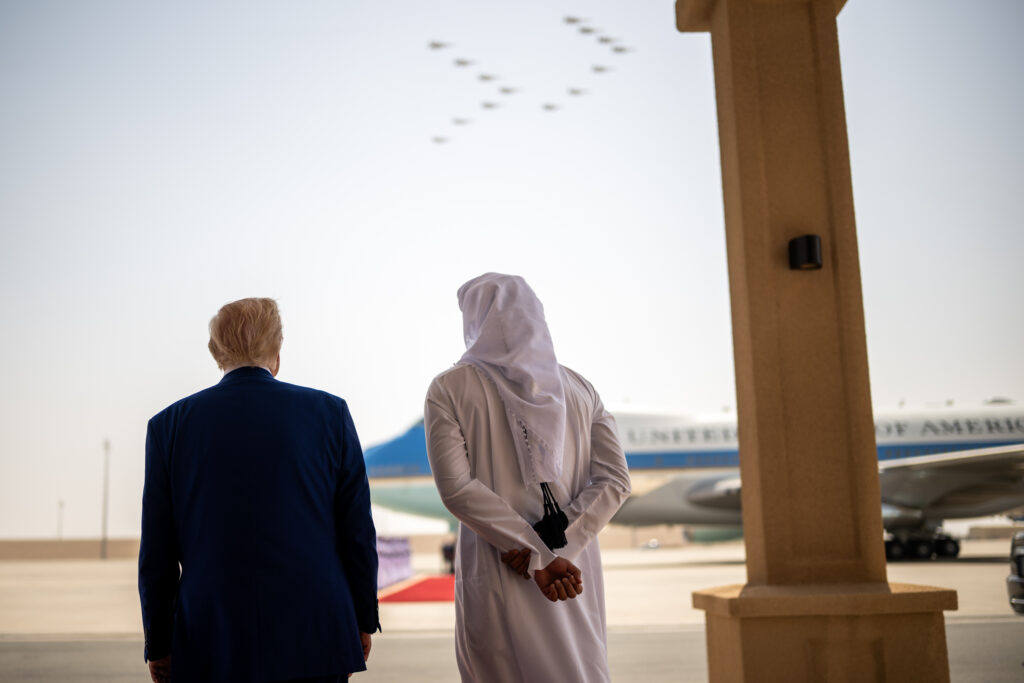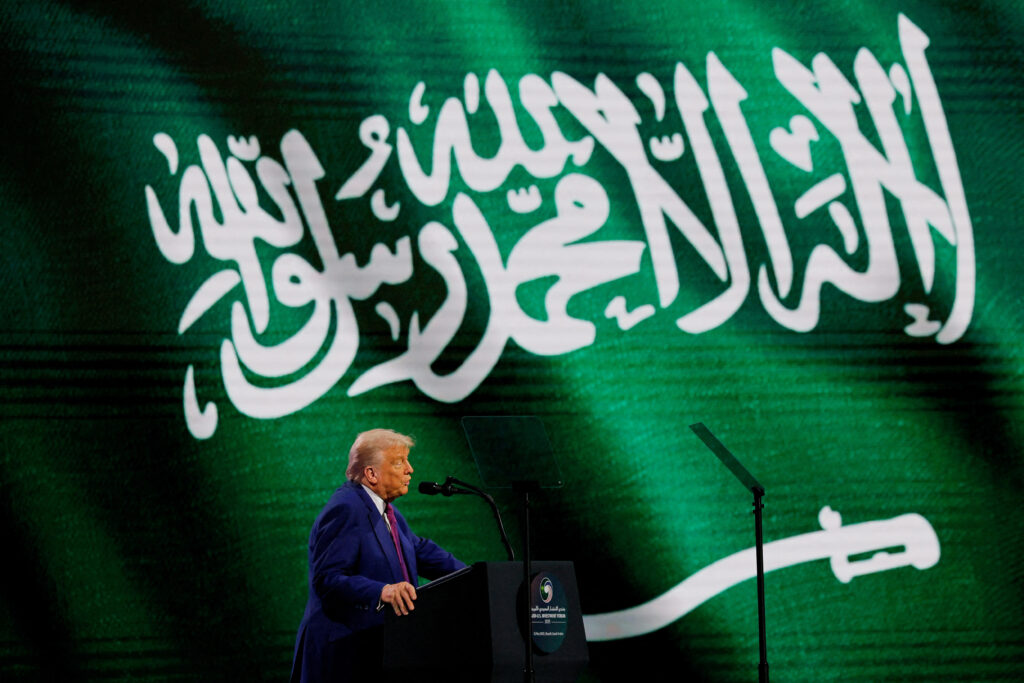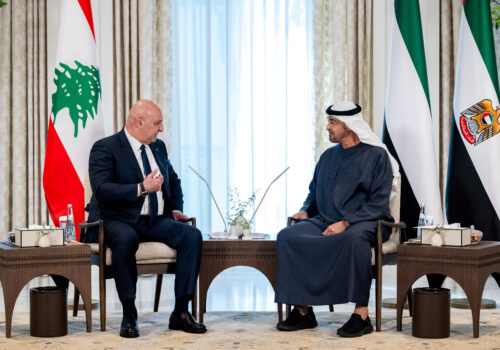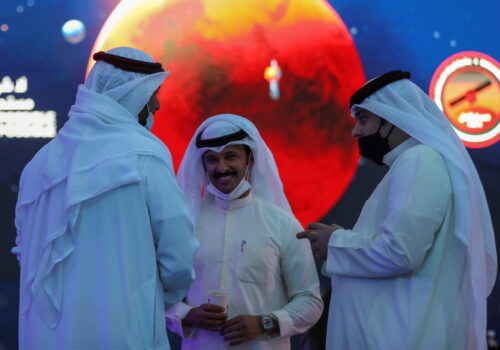On his landmark visit to the Gulf last week, US President Donald Trump declared in Saudi Arabia that he has “launched the Golden Age of America.”
He added, “the Golden Age of the Middle East can proceed right alongside of us.”
With vast sovereign wealth funds and fast centralized leadership for quick decision-making, the Gulf—primarily Saudi Arabia, Qatar, and the United Arab Emirates (UAE)—has become the most attractive foreign partners for the US president.
Trump’s 2025 visit follows a familiar pattern compared to his first term, where he also began his first major diplomatic visit in Riyadh. But this time, the trip’s reach and scope expanded to much broader horizons. Unlike his first Gulf trip in 2017, where the majority of the deals focused on defense, this visit signaled a realignment centered on tech-forward partnerships and putting the Gulf at the core of a new kind of relationship driven by economic return and shared strategic concerns (preventing Iran from developing a nuclear weapon and countering its regional influence, preserving regional stability, and securing energy markets and maritime routes, among others).
The trip also reflects a more intentional US pivot to the Gulf, especially given the key role the region can play in the technological world, the next battlefront between the United States and China. In the president’s global hierarchy, the Gulf is the new business frontier.
This pivot by the US president, in lieu of anchoring US strategy in traditional alliances such as the United Kingdom or Israel, suggests a new alignment with resource-rich, stable partners who can offer transactional stability in governance and significant return on investments.
This US “Golden Age” for the Gulf is one rooted in strategic utility, equal footing, high-stakes deals, and fewer strings. This Trump doctrine focuses more on regional return-on-investment and less on democratization. This resonates more with Gulf leaders’ preferences and acknowledges their agency as architects for the region’s future, not just clients.
Paired with the optics and symbolism of skipping Israel, Trump’s approach could signal a more pragmatic regional posturing that no longer places Israel at the center of Washington’s regional relations when it doesn’t serve US interests. Gulf capitals no longer serve as bases to project US power, but as strategic anchors in Washington’s foreign policy goals.
Tech-forward trade at the frontline of US-China competition
The visit’s focus on technology deals, contrasted against the defense focus of Trump’s 2017 trip, demonstrates this evolving US-Gulf dynamic and Washington’s increased effort to combat Beijing’s economic and trade encroachment in the region.
The US is rapidly adjusting to the post-unipolar world where China gains more influence, and competition for markets and strategic alliances is at full speed. Over the past few years, China has evolved from a technology importer into a global digital power, with state-backed tech giants such as Huawei, ZTE, and Alibaba Cloud rapidly expanding their digital footprint across the Gulf—including in critical infrastructure such as 5G networks and artificial intelligence (AI)-enabled surveillance systems. Via its “Digital Silk Road” initiative, Beijing has offered Gulf countries technological solutions at the scale, speed, and turnkey financing they need.
China’s rapid advance in the Gulf reflects its broader ambitions to shape regional tech norms and digital governance frameworks. The embedding of Chinese platforms and systems into Gulf digital infrastructure poses long-term security challenges to further cooperation with the United States.
If Washington wants to compete with Beijing on emerging technologies, it is right to realign its Gulf strategy. The region is prioritizing its own artificial intelligence ambitions with its post-oil development agenda, and would be among the first to experience Washington’s burgeoning tech diplomacy and competition with Beijing.
Gulf leaders, for their part, will need to decide how to move forward with this upgraded partnership with Washington vis-à-vis China. They are likely to continue hedging to get the best deals from both countries.
Qatar’s positioning from major non-NATO ally to strategic partner?
Trump’s stop in Qatar—the first state visit by a US president to Doha—was an important recognition of the tiny Gulf country’s strategic positioning as a bridge across regional ideological divides, for example, when dealing with the Taliban. While Saudi Arabia and the UAE are also strategic partners in the region, and US presidents have visited them on multiple occasions, the visit to Doha marked a turning point in how the United States sees and engages Qatar.
The visit also highlighted the tiny country’s efforts to elevate its profile by gifting a Boeing 747 intended for the Air Force One fleet—a made-for-headlines move that underscored Qatar’s desire to make waves.”

Trump’s Doha stop indeed facilitated the signing of significant deals, such as Qatar Airways’ purchase of 210 wide-body jets from Boeing aircraft, valued at approximately $96 billion—the largest in the company’s history, and defense agreements totaling nearly three billion dollars. The purchase lifted Boeing out of a significant crisis—not only helping one of the most iconic US manufacturers, but also reinforcing the administration’s narrative that its foreign deals can directly support US jobs and industries while keeping American-made aircraft competitive in the global stage.
Qatar’s decision to invest an additional ten billion dollars in Al Udeid, the largest US military hub in the Middle East, announced during Trump’s visit underscores the base’s strategic value to Qatar’s security and highlights it as a US ally that shares the burden of regional security with Washington—unlike other US partners, like in Europe, that Trump has accused of being defense free-riders.
The view from the Gulf
Regional analysts and the media have largely framed Trump’s visit as a reset to US foreign policy in the Middle East and a redefinition of regional leadership—one increasingly directed from Riyadh, Doha, and Abu Dhabi.
Badr al-Saif, an assistant professor of history at Kuwait University, argues that the region welcomes the current shift away from legacy alignments with the Gulf.
“To those in the Gulf who thought that the only way to America was through Israel, now we see an opening where we can go directly to the States,” he told The Wall Street Journal.
SIGN UP FOR THIS WEEK IN THE MIDEAST NEWSLETTER
Mohammed Baharoon, Director General of the Dubai-based think tank B’huth, adds, “Trump sees in the GCC (Gulf Cooperation Council) what China, India, and others are seeing there, which is its role as a mega connector.”
Hasan Alhasan of the International Institute for Strategic Studies notes that the Gulf states “have managed to use their role as mediators to position themselves as indispensable partners for Trump’s political agenda.”
The message coming out of the region seems to be consistent: the Gulf is no longer a side player—it is now helping set and lead the agenda in the Middle East. This is also a reflection that most Gulf states want to shape regional and global dynamics (via sovereign wealth fund diplomacy, for example), seeing themselves as independent middle powers capable of carrying out complex diplomatic initiatives with full ownership, after decades of having external powers shape their geopolitical dynamics and mostly being hubs of power projection and support.
Is “America’s Golden Age” Gulf-aligned?
Given their strategic geography, significant financial resources, relatively permissive regulatory environments, and massive energy surpluses, Gulf states are likely to continue leading the way in becoming hubs for AI and emerging technologies. Saudi Arabia, Qatar, and the UAE, for example, are just a six to eight-hour flight from 80 percent of the world population, with over 170 million passengers each year transiting through their capitals.
The Gulf’s ability to deploy capital is poised to be a key in powering US AI infrastructure as energy demand is set to surge, and the Trump administration’s prioritization of the US-Gulf partnership should be commended.
The Trump administration is clearly signaling that it is not bound to traditional alliances. In this new world, Gulf states are emerging as key economic and political players in the region and internationally, vital to technology development as well as the US-China rivalry. Against this emerging backdrop, Washington has positioned itself accordingly.
Joze Pelayo is an associate director at the Atlantic Council’s Scowcroft Middle East Security Initiative, where he manages the China-Middle East and the US-Gulf security cooperation portfolios.
Further reading
Mon, May 12, 2025
Landmark UAE visit highlights President Aoun’s catch twenty-two
MENASource By Jean-Loup Samaan
Modest outcomes from the Lebanese president's visit reflects that Abu Dhabi remains cautious towards Beirut.
Fri, Apr 25, 2025
Geopolitics in orbit: What Gulf moonshots mean for Washington
MENASource By
On a multipolar world stage with Russia and China power competition, it’s clear that space collaboration has all-too-earthly impacts.
Tue, May 13, 2025
Experts react: Trump just announced the removal of all US sanctions on Syria. What’s next?
New Atlanticist By
Our experts provide their insights on how the removal of US sanctions on Syria would affect the country and the wider region.
Image: U.S. President Donald Trump attends the Saudi-U.S. Investment Forum, in Riyadh, Saudi Arabia, May 13, 2025. REUTERS/Brian Snyder TPX IMAGES OF THE DAY




